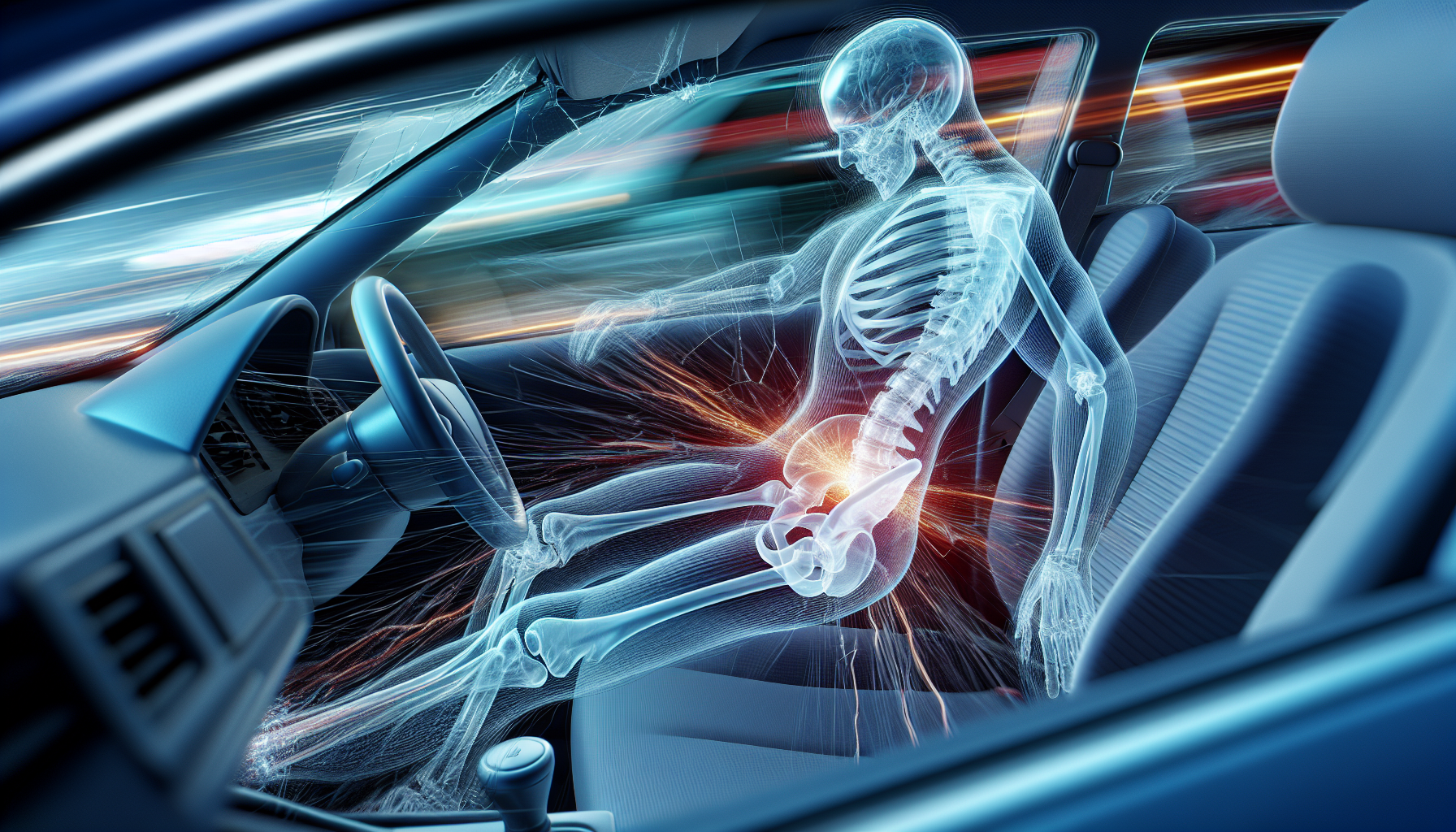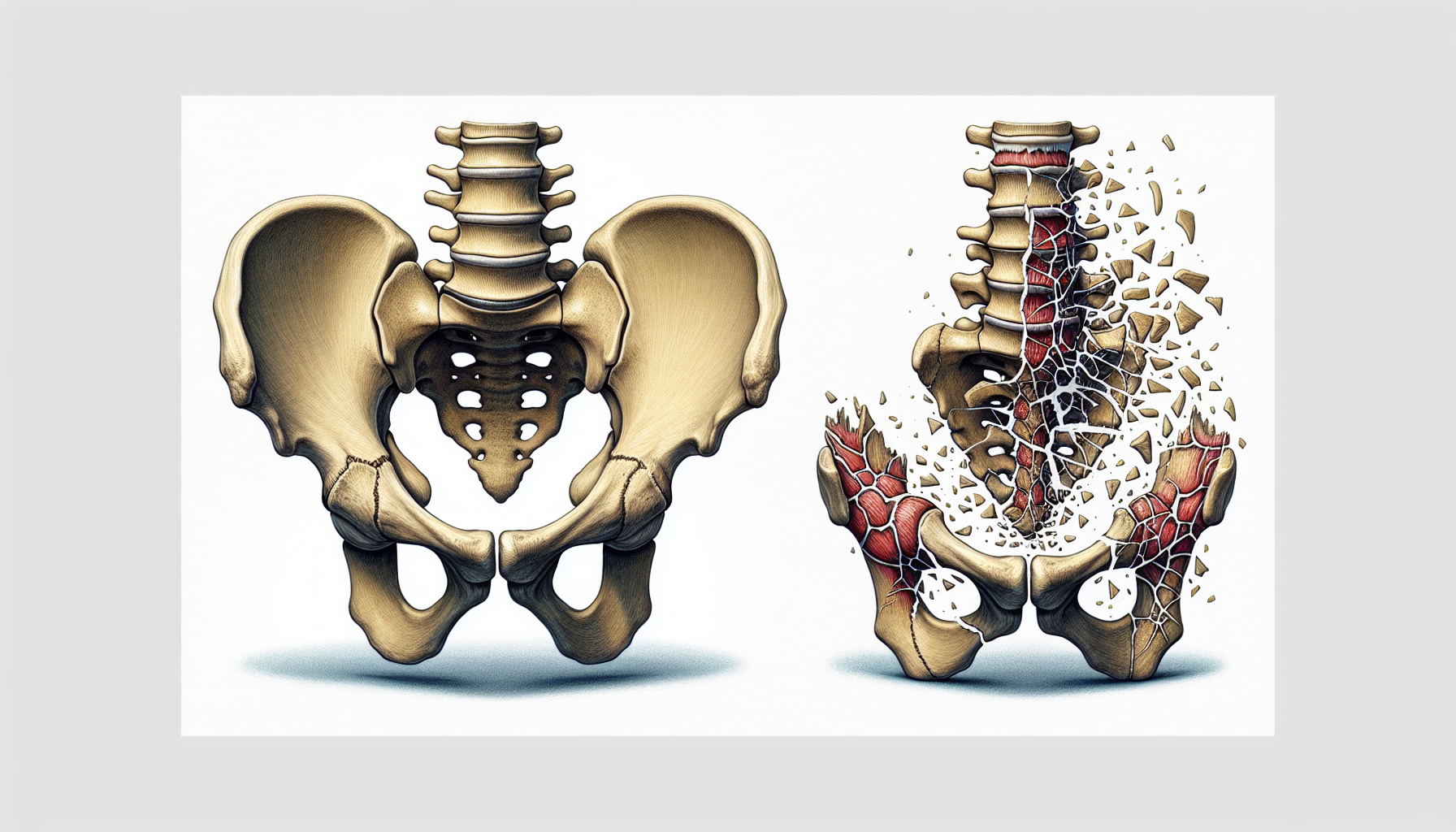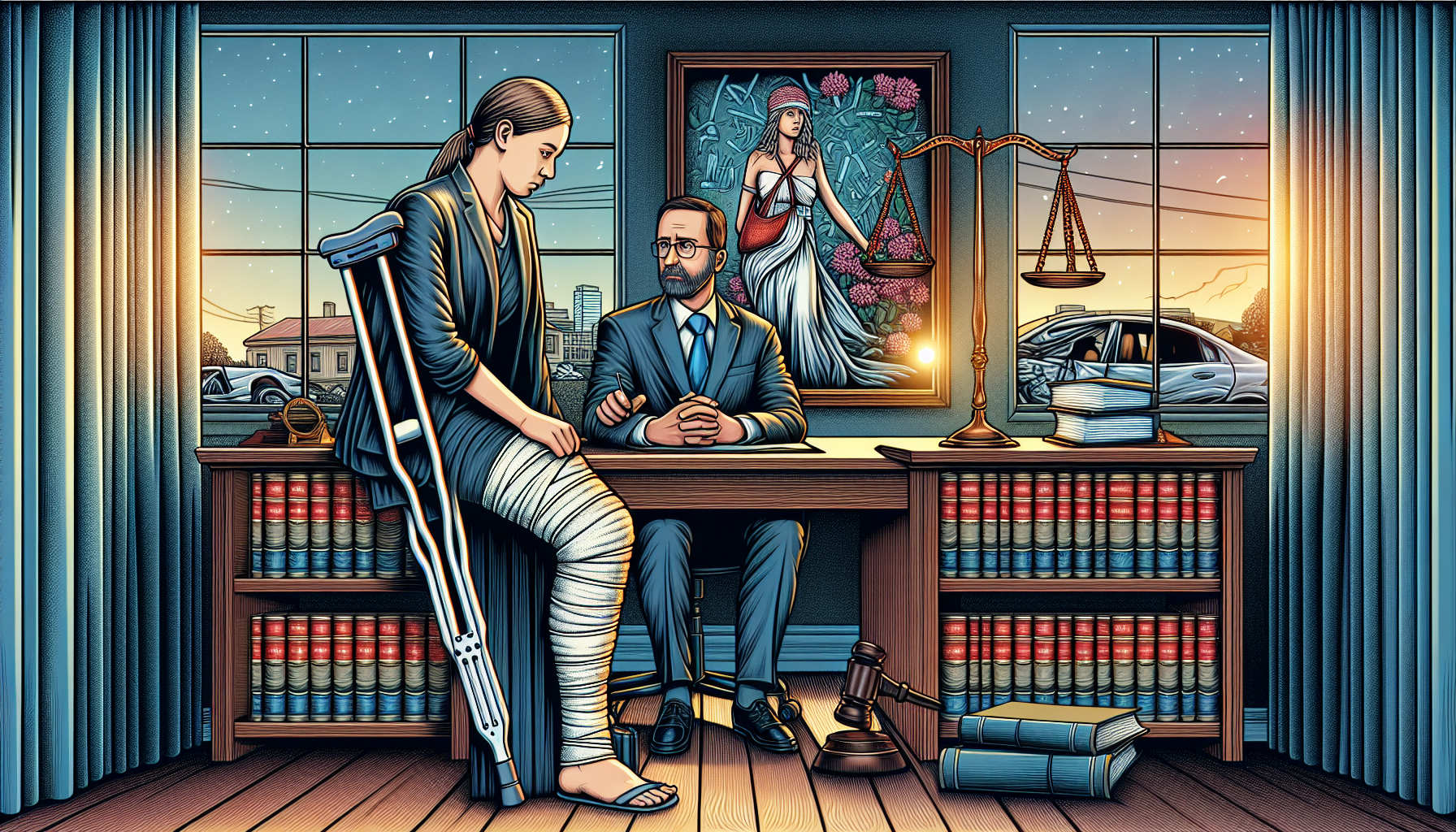Surviving a car accident only to be diagnosed with pelvic bone fractures from a car accident can be overwhelming. Immediate concerns typically include the severity of the injury, the healing process, and the impact on your mobility and independence. This article provides straightforward answers about the critical first steps in your treatment plan, realistic expectations for recovery, and guidance on managing the long-term effects of such a potentially life-altering injury, without overwhelming you with technical jargon.
Key Takeaways
Pelvic fractures from car accidents can range from stable to unstable, with variations such as anterior-posterior compression injuries, lateral compression injuries, and injuries due to safety devices like seat belts.
Immediate and correct diagnosis of a pelvic fracture is critical, requiring swift intervention and treatment, which may include surgical procedures for complex fractures to manage bleeding, provide stabilization, and minimize complications.
Recovery from pelvic fractures involves extensive rehabilitation and may lead to substantial financial impact and lifestyle changes, as well as potential legal claims for compensation if the injury resulted from another’s negligence.
Understanding the Impact: How Car Accidents Cause Pelvic Fractures

Different types of car accidents can result in various pelvic fractures, each bearing unique characteristics and complications. Head-on collisions, for instance, apply extreme force on the pelvic region, often resulting in multiple breaks. Frontal crashes can cause anterior-posterior compression injuries, potentially causing severe damage and even death from massive bleeding.
Lateral compression injuries from side-impact crashes also contribute to the risk of pelvic fractures, along with injuries to the brain, lungs, and upper abdominal organs. Seat belts, while essential for safety, can apply significant stress to the pelvic area, potentially causing fractures.
The common mechanisms of injuries for pelvic bone fractures in car accidents include impacts from the steering wheel, seat belts, and the front impact collisions and force of the crash itself, often leading to associated injuries.
Identifying Pelvic Injuries Post-Accident
Prompt and effective treatment relies on the accurate identification of pelvic injuries after an accident. Common symptoms of pelvic injuries include:
Severe pain
Difficulty in walking
Bruising in the pelvic area
Intense, sharp pain in the hip or groin
Swelling
Tenderness at the injury site
These indications may suggest a pelvic fracture, such as an iliac wing fracture.
In some cases, a pelvic fracture can cause the following signs and symptoms:
Inability to bear weight on the affected hip
Trouble urinating
Difficulty walking
Numbness
Pain surrounding the pelvis and abdomen
An open fracture, where a bone protrudes through the skin, is a direct and visible sign of a pelvic injury and often indicates broken bones.
During a physical exam, doctors assess for signs of a pelvic injury by checking the extent other signs of swelling, bruising, and tenderness.
The Anatomy of a Pelvic Fracture

Protecting internal organs and serving as an anchor for muscles, the pelvis is a complex structure located at the base of the spine. Pelvic fractures can occur in various forms, classified as stable or unstable. Stable fractures often involve single breaks with minimal internal bleeding due, while unstable fractures feature multiple breaks that can lead to organ and major blood vessel damage.
With modern diagnostic imaging techniques such as X-rays, CT scans, and MRIs, doctors can determine the location and pattern of pelvic fractures.
Classifying Pelvic Fractures
Pelvic fractures are classified using systems such as the Tile classification, which is based on stability, and the Young-Burgess classification, which categorizes injuries based on the mechanism. The Tile classification divides pelvic fractures into Type A (stable), Type B (rotationally unstable but vertically stable), and Type C (both rotationally and vertically unstable).
Type A fractures include minor injuries with no disruption of the pelvic ring, Type B fractures are rotationally unstable, and Type C fractures represent complete disruption of the pelvic ring with high potential for severe injuries. The various mechanisms of force applied during injury, including anterior-posterior compression (APC), lateral compression (LC), and vertical shear (VS), each contribute to the type of injury sustained.
Associated Risks and Complications
A myriad of complications can arise from pelvic fractures, including severe pelvic damage. Neurological complications can occur due to potential damage to nerves like the sacral plexus and sciatic nerve, which may result in a nerve injury. Urethral injuries and other urinary complications are significant risks, especially in males, from severe pelvic fractures.
Damage to reproductive organs within the pelvic ring can lead to various complications, including:
Chronic pain
Sexual dysfunction
Deep vein thrombosis
Pulmonary embolism
Infections
Difficulty with walking or standing
There is an elevated risk of these complications during surgical interventions.
When Surgery Is Necessary
The complexity of most pelvic fractures, such as a fractured pelvis, arising from car accidents may necessitate surgical intervention to tackle multiple breaks and related injuries. In contrast, stable pelvic fractures often require less invasive treatment options. An unstable pelvic fracture often necessitates multiple surgical procedures, including external fixation, skeletal traction, or open reduction and internal fixation, to ensure proper healing and stabilization.
Swift identification of the need for surgery is vital to manage life-threatening conditions and severe injury promptly, following the Advanced Trauma Life Support (ATLS) guidelines. Proper surgical treatment can lead to better fracture reductions, improving the long-term outcomes for most patients.
First Steps in Treatment and Stabilization
The initial focus of treatment, once a pelvic fracture is identified, revolves around managing bleeding and ensuring mechanical stabilization. Bleeding is a major issue in pelvic fractures due to the presence of many major blood vessels there, and patients may need blood transfusions or surgery to manage the hemorrhage. High-energy pelvic fractures can lead to significant blood loss resulting in shock and potentially organ failure, necessitating immediate blood transfusion and stabilization.
Initiating massive transfusion protocols early is vital for pelvic fracture patients to prevent metabolic deterioration and control blood loss. Mechanical stabilization, including the application of pelvic binders, external fixators, or C-clamps, is an essential first step in treating hemorrhagic instability from pelvic fractures. In some cases, the use of screws or metal plates may be necessary for further stabilization. When initial stabilization and hemorrhage control methods prove suboptimal, procedures such as resuscitative endovascular balloon occlusion of the aorta (REBOA) may be considered, despite potential complications.
Long-Term Recovery and Rehabilitation

Recovering from a pelvic fracture is a lengthy journey. It involves extensive rehabilitation, physical therapy, and lifestyle adjustments. Patients may walk with a limp for several months post-injury while early mobilisation during rehabilitation is essential to prevent complications like respiratory and circulatory dysfunction.
Physical Therapy's Role
Post pelvic fracture, physical therapy becomes pivotal in regaining flexibility, restoring range of motion, and building strength and endurance. Rehabilitation begins with non-weight bearing exercises, advancing to weight-bearing activities as the patient’s condition improves.
Gait training, incorporating walking between parallel bars and using mobility aids such as walkers or canes, is a critical aspect of physical therapy. Training aimed at improving balance and full body proprioception is included in the regimen to address possible long-term gait and posture disturbances. The physical therapy program also integrates resistive and cardiovascular exercises to enhance overall muscle strength and endurance.
Coping with Life Changes
Significant life changes can be induced by pelvic fractures, necessitating adjustments in home and workplace environments to enhance accessibility. Physical therapy is crucial for managing chronic pain, a common issue in long-term recovery from pelvic fractures.
Physical therapy also helps manage chronic disabilities by improving physical functionality and the patient’s ability to perform daily roles post pelvic fracture. Access to appropriate walking aids and participation in falls prevention programs are fundamental to enhancing safety and independence during recovery.
Psychological support is often required to assist patients in coping with persistent pain and mobility challenges that arise from severe pelvic injuries.
Financial Implications of Pelvic Injuries

With treatment costs varying widely, the average cost of treating a pelvic fracture ranges from $33,395 to $50,856 based on the hospital for private insurance providers, and for open procedures in metropolitan facilities, it can escalate to over $140,000. Survivors of severe pelvic fractures may face significant long-term financial challenges, including the cost of inpatient treatment, which is typically twice as much as outpatient treatment, and unemployment due to chronic disabilities.
Compensation amounts for pelvic fracture victims can be influenced by the severity of the injury, the patient’s age and activity level, and the long-term effects such as permanent loss of motion or development of arthritis. Personal injury attorneys are instrumental in strategically presenting the non-economic damages components of a case, which can maximize the compensation received by victims of broken pelvis and other injuries.
Legal Recourse for Car Accident Victims with Pelvic Injuries

Individuals who have sustained pelvic trauma in a car accident can seek assistance from a personal injury attorney for compensation regarding medical expenses, lost income, property damages, and pain and suffering. Victims with pelvic injuries can consult a lawyer before giving a statement and can demand damages for physical injuries, emotional suffering, property damage, and lost wages when negligence is involved.
Car accident victims have the right to file a lawsuit if the insurance company’s settlement offers are inadequate, especially after a personal injury attorney assesses factors like negligence that contributed to the accident. Settlements for pelvic fractures resulting from car accidents can vary significantly, with some case results ranging from $23,000 to $650,000, while the average compensation for a broken pelvis is estimated at around $220,000.
Summary
To wrap up, pelvic fractures from car accidents can lead to significant physical, emotional, and financial challenges. Understanding the causes, symptoms, and treatment options, along with the long-term implications of these injuries, can equip you to navigate the path to recovery more effectively. Remember, recovery is a journey, and with the right information, support, and legal advice, you can overcome the challenges and regain control over your life.
Frequently Asked Questions
Can you fully recover from a fractured pelvis?
Yes, most people with a broken pelvis can fully recover and return to their prior activities and function within 4-6 months if surgery is successful and no complications occur.
Can a car accident cause a person to have a broken pelvis?
Yes, a car accident, especially a high-speed collision, can cause a person to have a broken pelvis due to the extreme force on the pelvic region. This type of fracture is uncommon and typically occurs during high-speed accidents or falls from great heights.
What are the signs of pelvic fracture in trauma?
If you experience sharp pain in the hip or groin, along with swelling, bruising, tenderness, and difficulty putting weight on the affected hip, it could indicate a pelvic fracture. Seek medical attention immediately.
How much compensation for fractured pelvis?
Compensation for a fractured pelvis can range from the 10's of thousands to much higher depending on the severity of the injuries and the specifics of the car accident.

